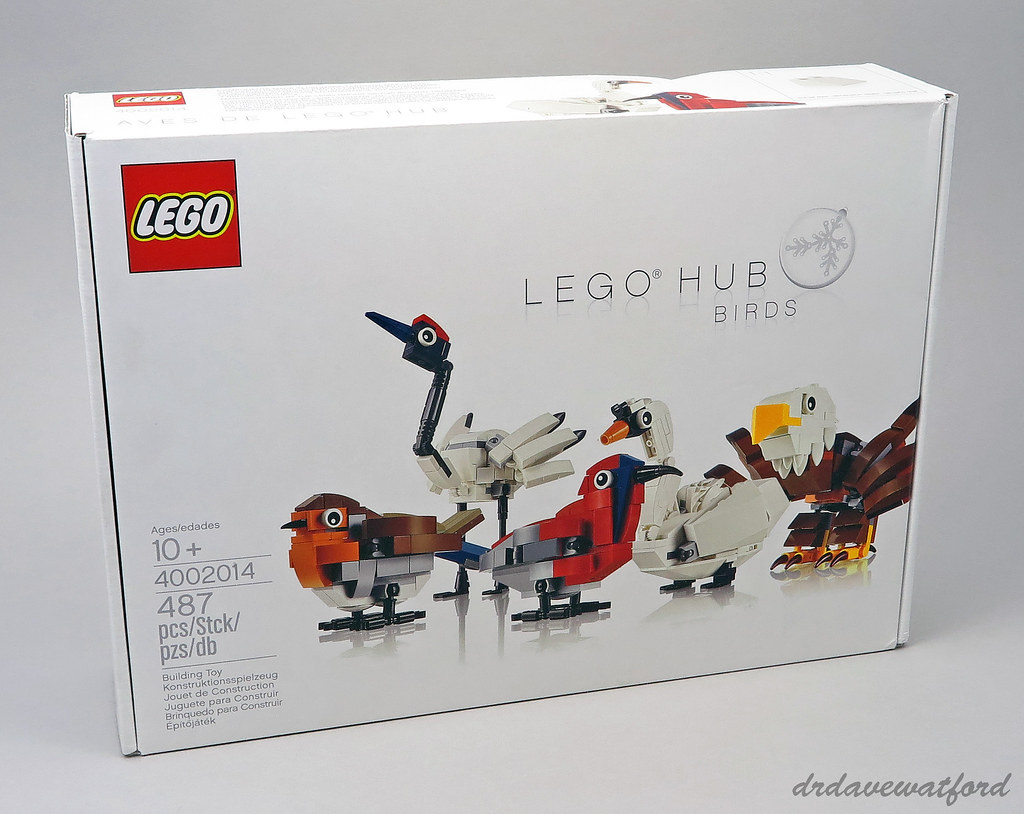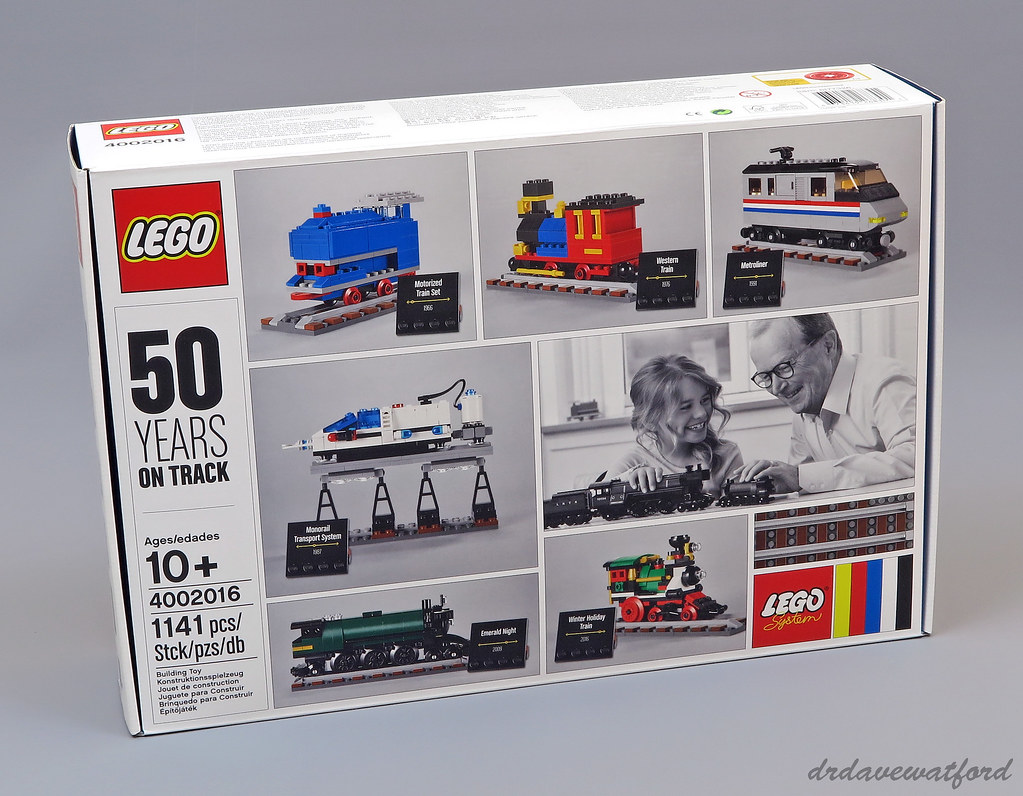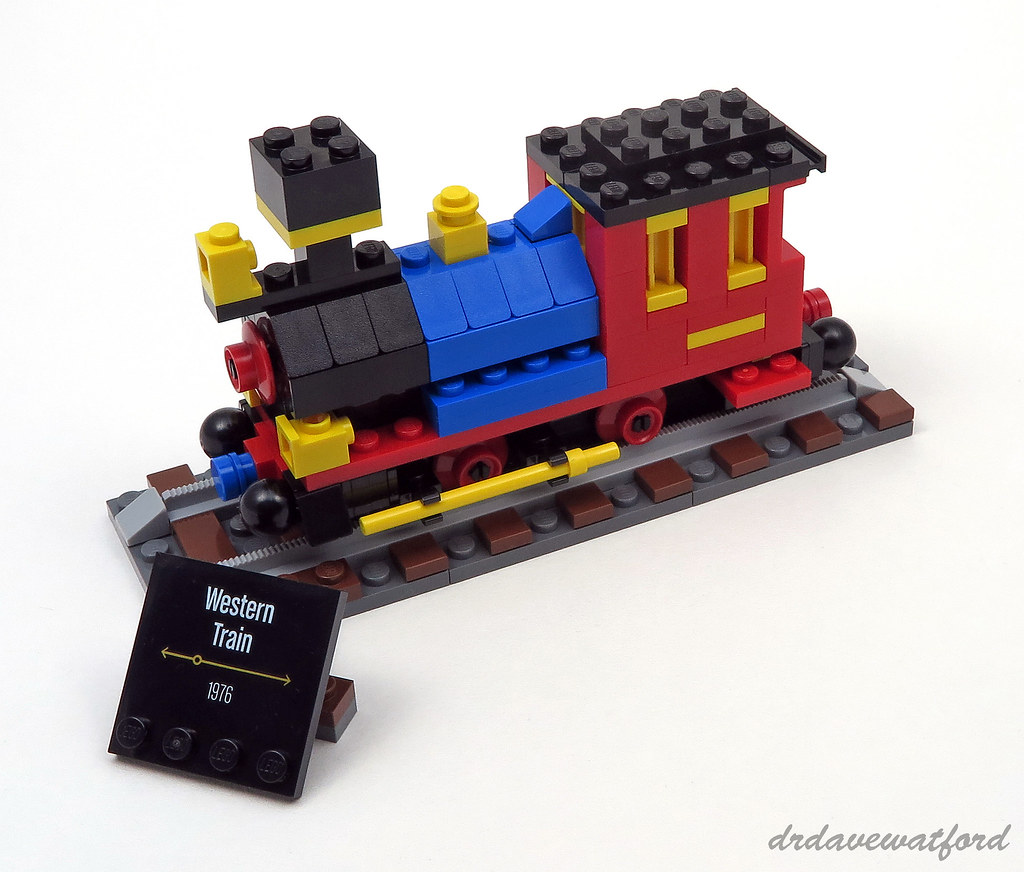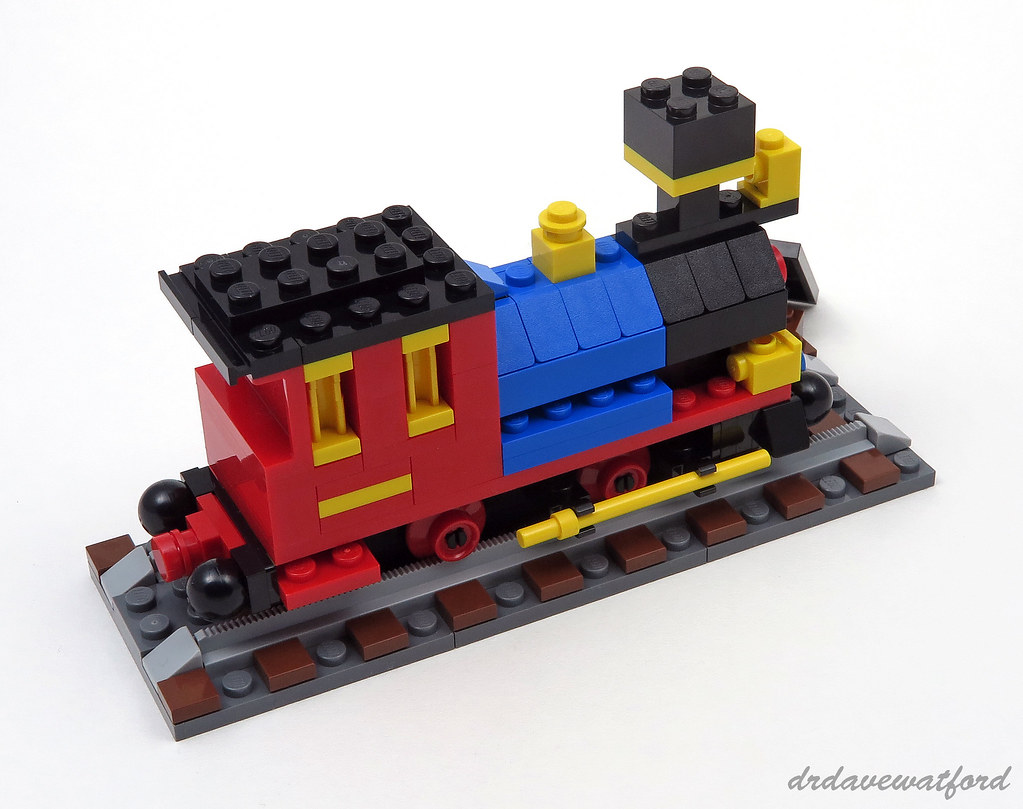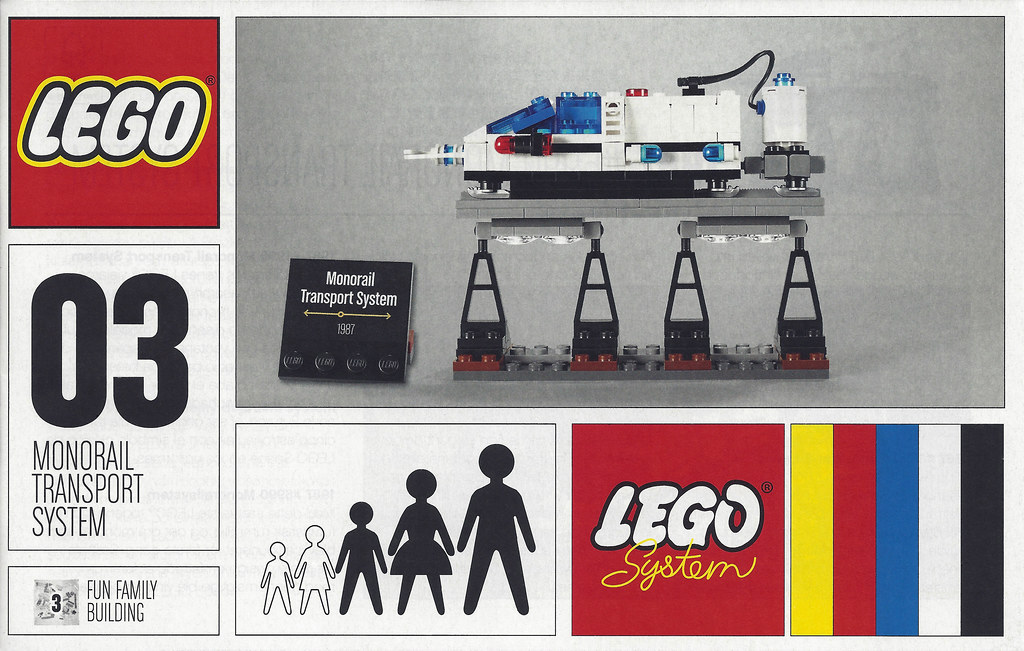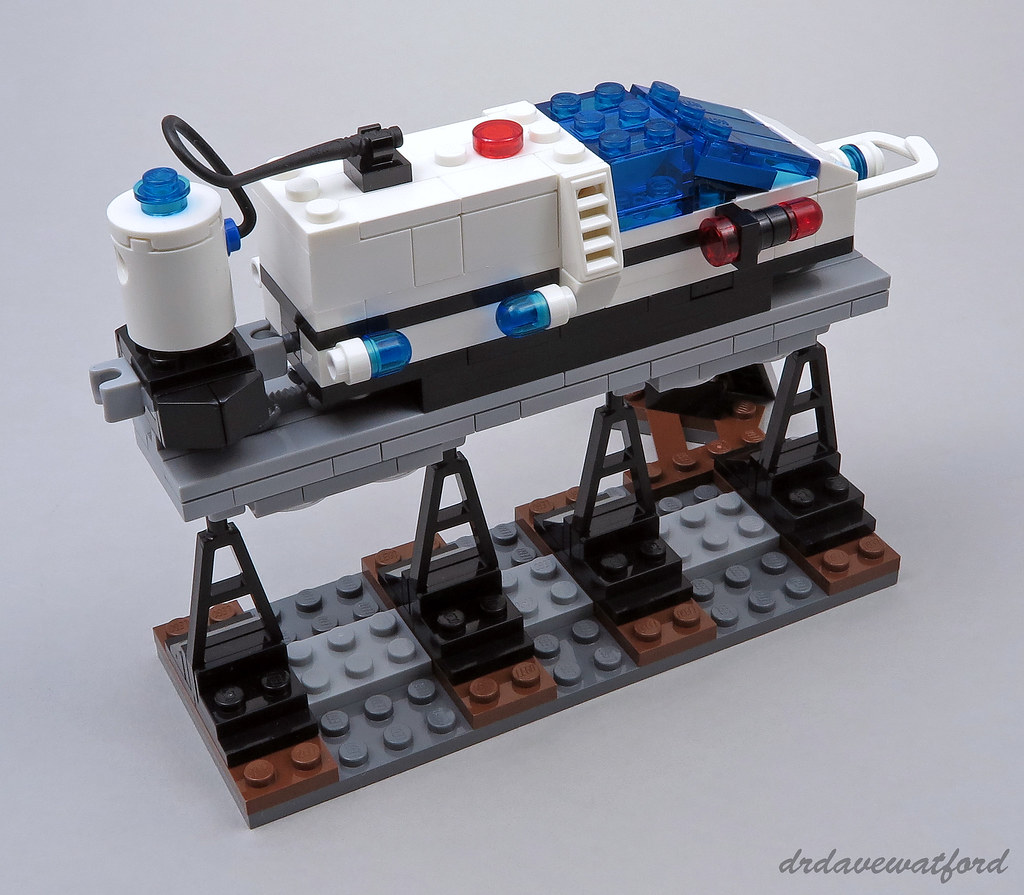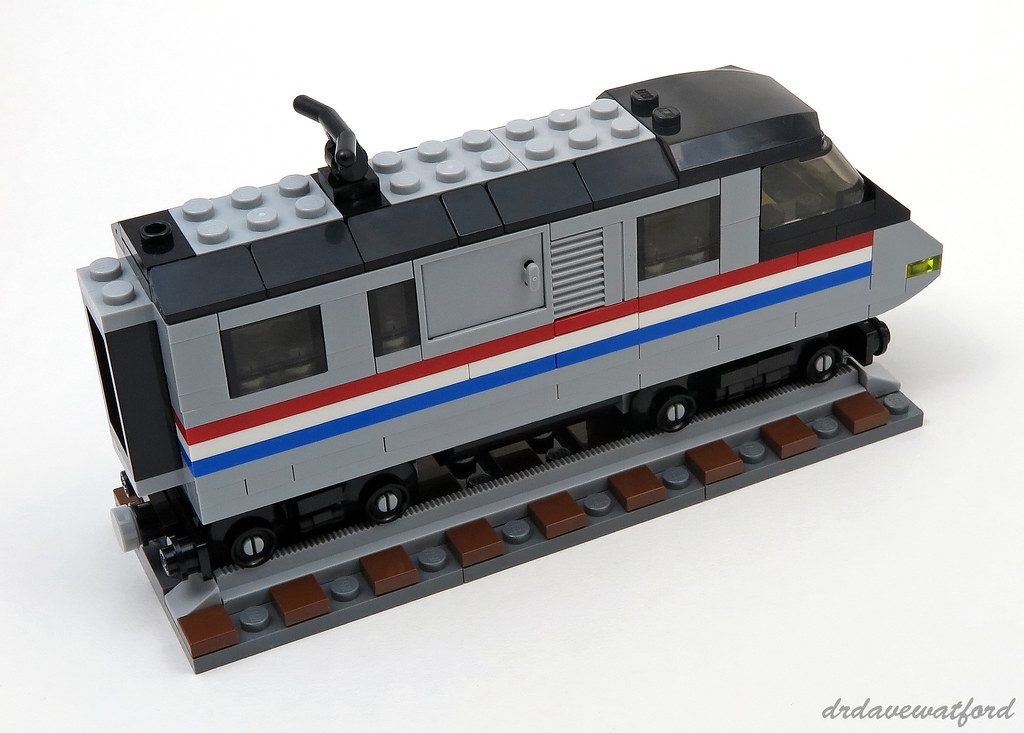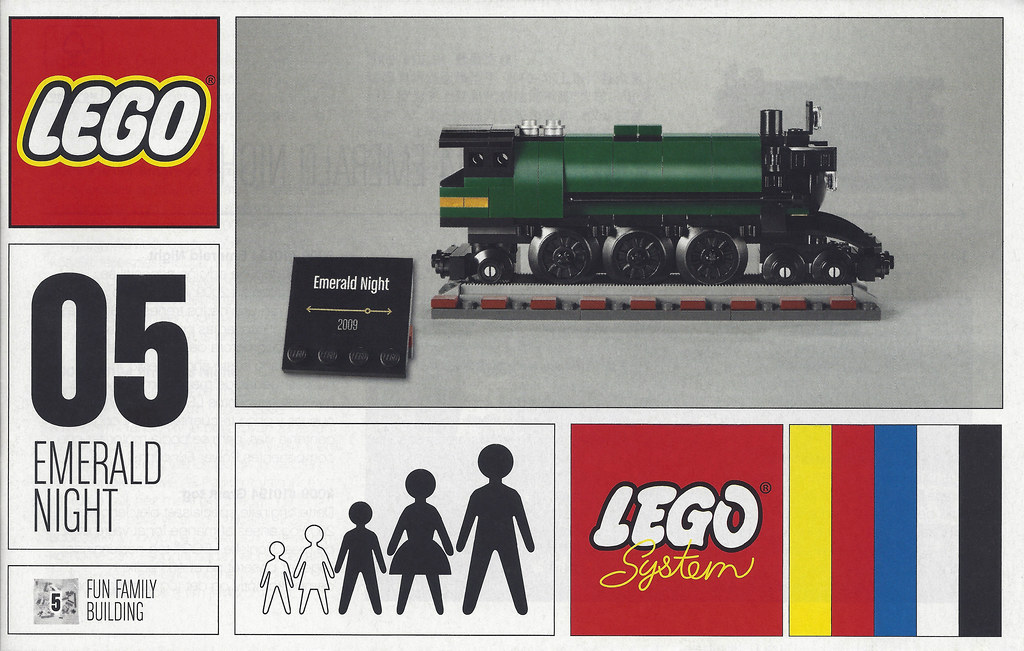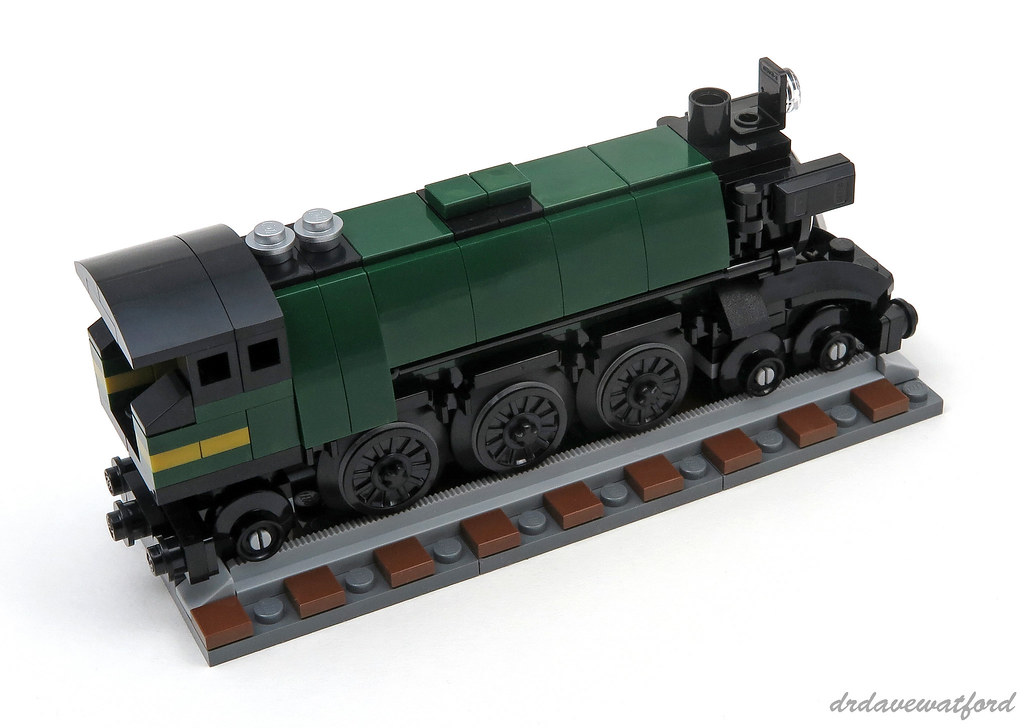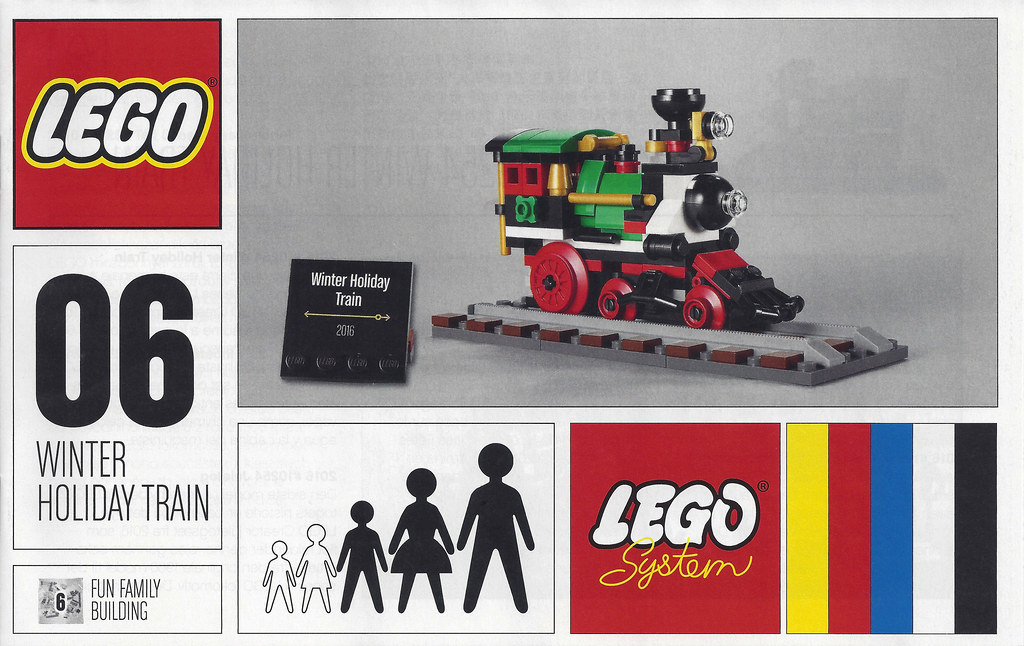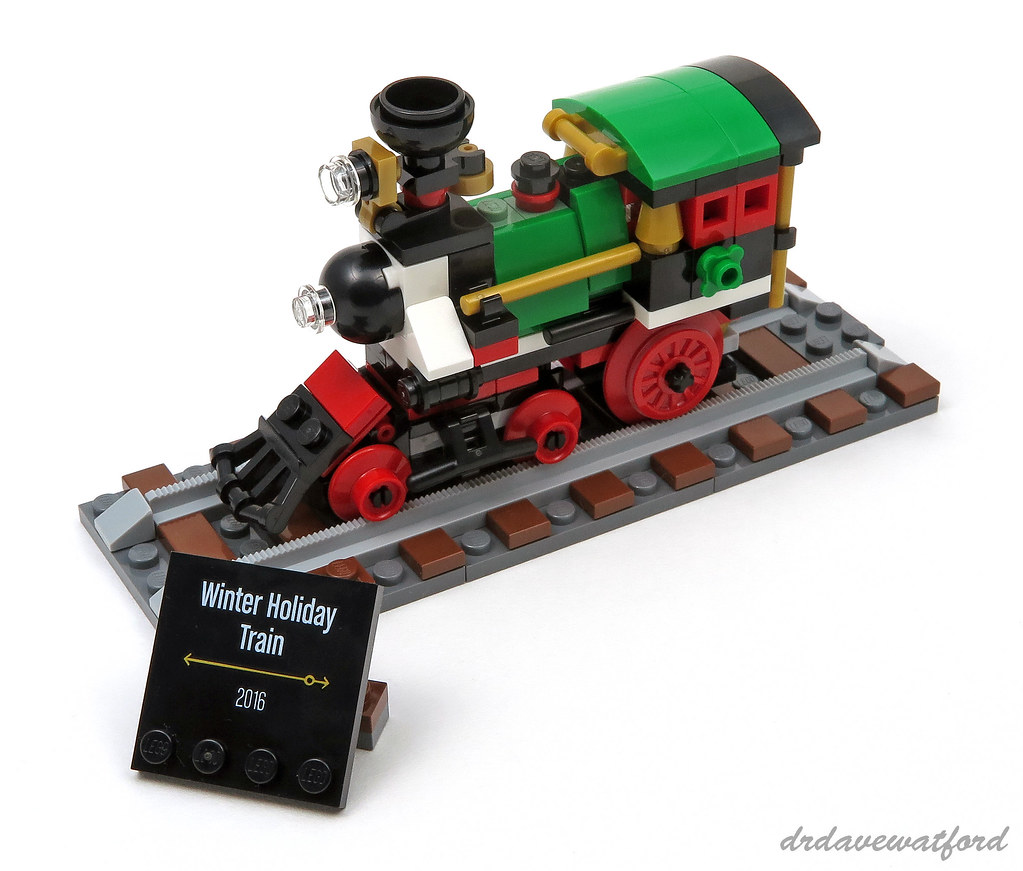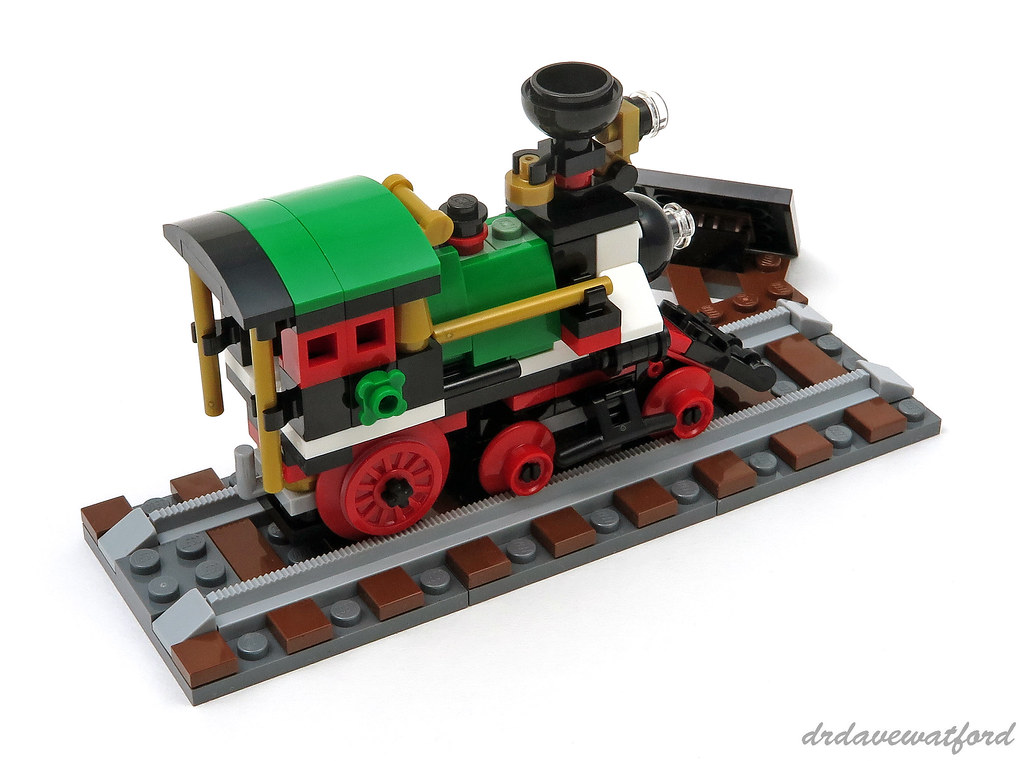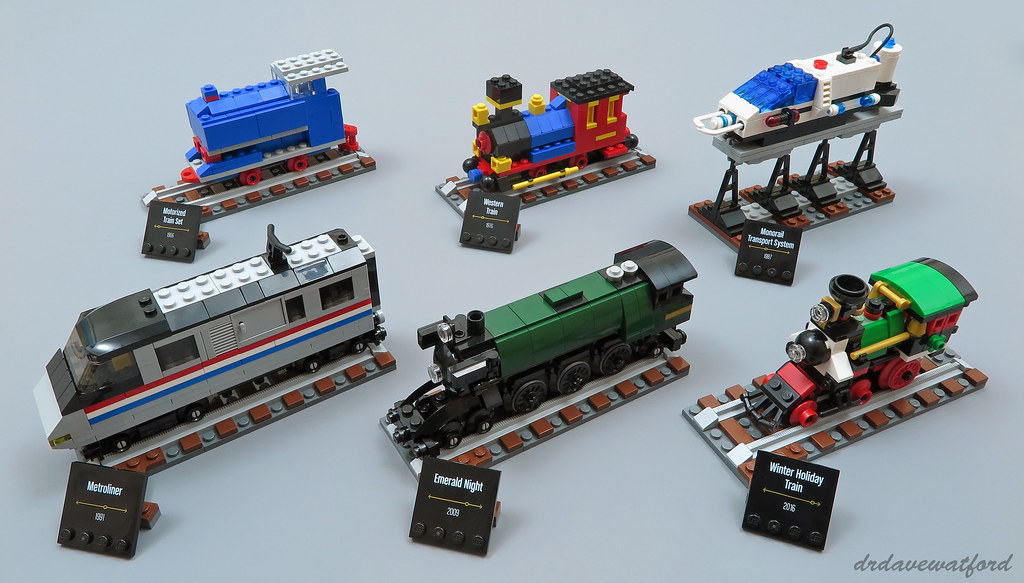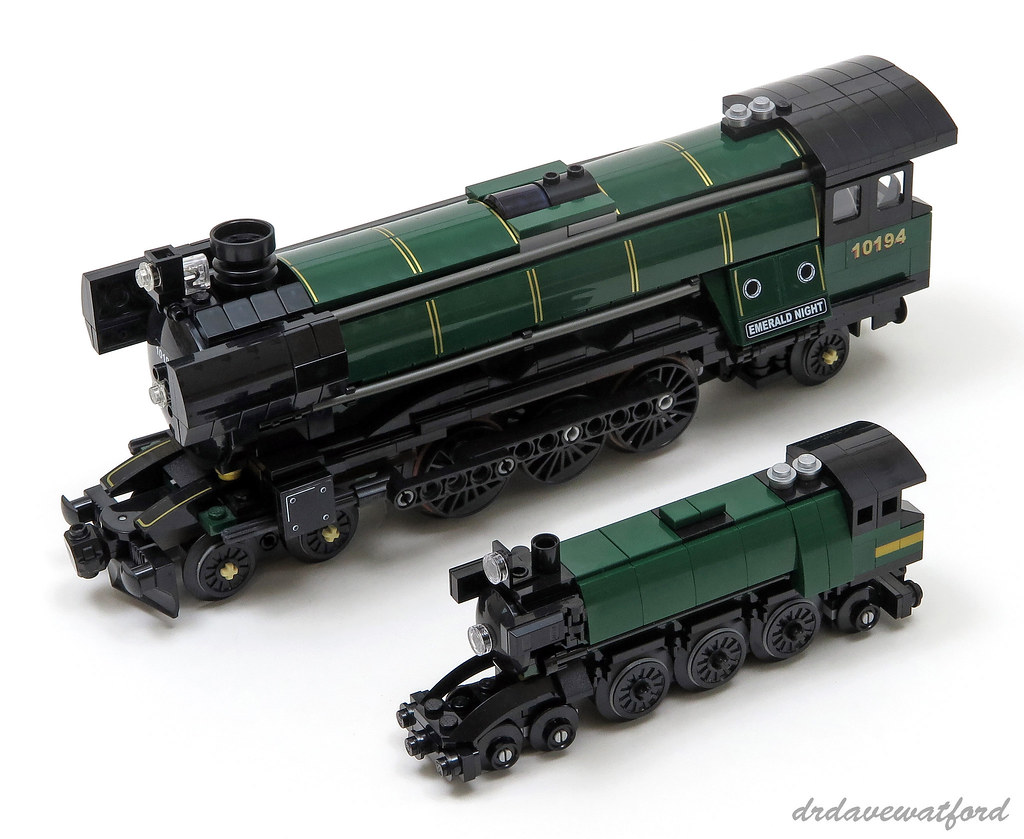While these employee sets aren't available at retail, it's nevertheless fairly easy for non-employees to get hold of them as some LEGO employees view them as an opportunity to make a quick buck and consequently sell them on eBay, Bricklink or elsewhere. They're not cheap, though - with the increase in popularity of LEGO and the rise of LEGO collecting as a hobby there's a ready market for such exclusive items, meaning that employees can get good money for them.
Of all the sets gifted to employees over the past few years, perhaps the most desirable of all from my perspective is 4002016 50 Years on Track from 2016 which is a celebration of 50 years of LEGO trains. The set contains predominantly 4-wide miniature versions of six different trains released by LEGO over the years, most of which can be considered noteworthy or iconic. As a fan and collector of LEGO trains I was predictably drawn to this set, and eventually took the plunge on a sealed copy from Bricklink which I bought for myself as a belated Christmas present!
The box leaves little to the imagination, showcasing all six miniature builds on the front (above). These images are accompanied by a black and white picture of Kjeld Kirk Kristiansen, former president and CEO of The LEGO Group, playing trains with a young girl. The same image appears on the back of the box (below), next to a picture of Kjeld's father Godtfred Kirk Christiansen playing trains with a young boy. I did wonder whether the youngsters might be family members, but the identities of the children are not stated. Given how much I paid for the set, I had to smile ruefully at a 'Not for sale' message printed in eight languages on the right side of the box....
The box opens in a similar fashion to a typical LEGO Architecture set. Cutting a couple of tape seals allows the front of the box to be lifted up, revealing Christmas greetings printed in a variety of languages on the front edge of the box. Nestled inside the box are six sealed bags of LEGO elements and six booklets containing building instructions. There's no sticker sheet.
Each individual build has its own numbered bag of elements and booklet. You can see the cover of the first booklet above; this 36-page booklet provides instructions for building a miniature version of the locomotive from 113 Motorized Train Set which was the first train that LEGO ever released back in 1966. All six booklets contain a brief introduction to the set which inspired their particular miniature build. The first booklet also contains a short introduction to the entire 50 Years On Track collection, while the sixth booklet contains an inventory of all the elements appearing in the set. All six booklets have the same back cover (below).
Construction of the miniature Motorized Train commences with the assembly of a display base. This incorporates a pair of light bley rails which have only previously appeared in four sets in this colour. The rails are mounted on dark bley 6 x 6 plates and are accompanied by an arrangement of reddish brown tiles which serve as sleepers. A display plaque consisting of a modified 4 x 4 tile with studs on one edge printed with the words 'Motorized Train Set 1966' is mounted on the edge of the display base by way of a reddish brown A-shape wedge plate with 2 rows of 4 studs and an uncommon reddish brown 2 x 2 top hinge plate.
The miniature locomotive itself is a fairly straightforward build which doesn't employ any particularly rare elements apart from small red train wheels which are exclusive to this set. Even so, it's a pretty good representation of the crudely-styled original locomotive, thanks in part to the use of a variety of modern elements such as single and double cheese slopes and jumper plates. You can see the original 1966 locomotive running in this video clip.
We jump forward 10 years for the subject of our second miniature train which is the locomotive from 726 Western Train released in 1976. According to the corresponding booklet (below) it's believed that set 726 was the inspiration for the Western locomotives that appeared in LEGOLAND shortly afterwards.
Once again the build commences with construction of a display base which is identical to that employed for the miniature Motorized Train apart from the printing on the display plaque. Similar to the previous build the train's headlights are fashioned from a pair of modified 1 x 1 headlight bricks which are laid on their backs thus making them 2- rather than 3-plates high, and again there's liberal use of jumper plates and cheese slopes which help to neatly mimic the original design at a smaller scale. The windows are formed from stacks of yellow modified 1 x 1 plates with vertical clip. This element exists in a number of different variants, and irritatingly those supplied with my copy of the set are a mixture of two different types and this is evident in the build as the clips don't line up as neatly as they should.
The sides of the boiler are fashioned from blue and black 45 degree 2 x 1 slopes with 2/3 cutout.
An uncommon yellow 1 x 2 x 2 panel with side supports makes an appearance at the front of the cab, while the back of the locomotive is made up of a red 1 x 4 x 2 panel with side supports; this element is only appearing in a set for the sixth time ever in this colour. The attention to detail is laudable - even the buffers and magnetic couplings of the original locomotive are modeled via the use of black Technic ball joints and red & blue 1 x 1 round tiles respectively. The coupling rods are also reproduced via the use of yellow 6L bars with stop ring which have only previously appeared in five sets in this colour. Overall, it's an excellent representation of 726 Western Train and a nice little display model in its own right.
AFOLs have been clamouring for the return of monorail for more than a decade now, and LEGO has steadfastly refused to bring it back, so it's perhaps ironic that the next set chosen to be immortalised in miniature form is the classic 6990 Monorail Transport System from 1987....
Consistent with the other builds the display base is first to be assembled, although uniquely in this case the base incorporates a section of elevated monorail track. The stanchions which support the single light bluish grey 16L track section upon which the monorail rests are represented by modified 1 x 2 plates with long towball.
The designers have done a cracking job of reproducing the full size monorail in miniature form, managing to nicely capture the overall shape and include most of the pertinent exterior details. Construction of the 3-wide chassis is facilitated by the use of an uncommon black 3 x 3 plate which is only appearing in a set for the tenth time in this colour and which forms a part of the floor of the monorail. Bionicle Barraki eyes are used to represent the characteristic trans-dark blue and trans-red lights on either side of the monorail. The full-sized monorail's 9V motor and connecting cable are particularly impressively reproduced, utilising a white robot body and a black flexible whip, while a pair of white hockey sticks, which were only previously available in eight sets in this colour, cleverly mimic the flexible hose which forms a loop at the front of the original model. There's also ingenious use of pairs of flat silver ice skates which attach to the underside of the body and are perfectly spaced to ensure that the monorail fits snugly on the single rail beneath and can smoothly slide backwards and forwards.
The classics just keep on coming with the much-loved 4558 Metroliner from 1991 next up for miniaturisation. Such was its popularity that the Metroliner was re-released in 2001 with a new set number (10001).
For the miniature Metroliner build we're back to using the same style of ground-level display base that was previously used for the Motorized Train Set and Western Train.
This is another great-looking miniature build which is once again pleasingly faithful to the original design. The distinctive red, white and blue stripes along the sides of the locomotive appropriately survive the miniaturisation process, as do various other prominent external landmarks. The front of the locomotive is fashioned from a variety of 45 degree slopes including black 2 x 1 45 degree slopes with 2/3 cutout and a trans-black 3 x 4 x 1 1/3 windscreen with 2 studs on top; all that's missing is a slope printed with the LEGO train logo from the 1990's. The attention to detail extends to the construction of twin bogies, each of which attaches to the underside of the train via a modified 2 x 2 tile with pin. This allows the bogies to rotate, which is impressive but ultimately unnecessary given that the train will never have to navigate a section of curved track. Black minifig handlebars representing a pantograph attach to the roof and complete the build.
We now come to the build that I was most looking forward to, the miniature version of 10194 Emerald Night which is one of my all-time favourite sets. Released in 2009, Emerald Night set a new standard for LEGO trains, and the high aftermarket prices are testament to its enduring popularity - it's an absolutely beauty!
Once again the same ground-level display base is utilized, and as a consequence there's only space to reproduce and display the locomotive itself - a miniature version of the tender is unfortunately not included in the build. That having been said, I don't think it would be particularly difficult to increase the length of the display base and design your own tender should you feel so inclined.
I'm pleased to report that the miniature Emerald Night doesn't disappoint - it's an excellent little build. Pretty much all of the key exterior detailing is reproduced apart from the connecting and coupling rods over the drive wheels. The front of the locomotive is cleverly sculpted by way of a black 4 x 3 wedge open with cutout and 4 studs, while the sides of the boiler are shaped via the use of 3 x 1 and 2 x 2 dark green curved slopes. Stickers featuring the set number in gold print are attached to the sides of the driver's cab in the original set; this detail is crudely reproduced here via the use of pearl gold 1 x 1 plates. The miniature build utilises six spoked train wheels with Technic axle hole and rubber friction band; fitting these is tricky as they need to be squeezed beneath tight overhangs, and in addition the 4L axles that attach them to the chassis are a very tight fit. The original Emerald Night features a total of six smaller front and trailing wheels in addition to its six large driving wheels, and these are also faithfully reproduced in the miniature version via more of the black small train wheels seen previously in the Metroliner miniature build.
The final build is a miniature version of 10254 Winter Holiday Train which was released in late 2016. This is in some ways a slightly surprising choice for inclusion in this collection given that it's such a recent offering and arguably not in the 'classic' bracket. Even so, it certainly brings the collection bang up to date.
After building the now-familiar ground-level display base for the fifth and final time, attention quickly shifts to the locomotive. Two sand green modified 1 x 1 bricks with studs on opposite sides, which are only appearing in a set for the second time, form part of the internal structure of the boiler, while the exterior of the boiler is shaped via the use of green 1 x 2 and 2 x 2 curved slopes with no studs. The roof of the driver's cab is made up of more green curved slopes, and a pearl gold modified 1 x 2 with handle on side - closed ends provides some decoration at the front of the cab.
The main drive wheels consist of a pair of red spoked train wheels with Technic axle hole and rubber friction band which are only appearing in a set for the second time in this colour, while four of the exclusive red small train wheels mimic the original's front wheels. The original Winter Holiday Train build featured a cow catcher at the front, and a black modified 1 x 2 plate with angled handles on the side does a good job of representing this in the miniature build.
With the miniature Winter Village Train build finished the full 50 Years on Track collection is complete and can be seen laid out below.
As a longstanding fan of LEGO trains I found this set to be an absolute joy to build. All six miniature models are superb representations of the full-size originals, and the attention to detail lavished on each of the builds is commendable. The set isn't quite perfect - given the choice I would probably have dropped the miniature Western Train and Winter Village Train and replaced them with miniature versions of any two of 396 Thatcher Perkins Locomotive, 7740 Inter-City Passenger Train Set, 6399 Airport Shuttle, or even 10233 Horizon Express. Minor gripes aside, however, the selection is undoubtedly varied and interesting, and I suspect that any longstanding fan of LEGO trains is pretty much guaranteed to find at least one of their favourites among them.
Similar to 41498 Boba Fett and Han Solo in Carbonite which I reviewed a few weeks back, it's a real shame that 4002016 50 years on Track was never available at retail and is thus destined to remain out of reach for many LEGO fans. If you want to acquire a copy of the set you'll need to venture on to the likes of Bricklink, which is what I did, or eBay; at time of writing, Bricklink prices start at around £125/$175 plus shipping for a new, sealed copy of the set. Not cheap, but I have no regrets - outstanding!
Once again the build commences with construction of a display base which is identical to that employed for the miniature Motorized Train apart from the printing on the display plaque. Similar to the previous build the train's headlights are fashioned from a pair of modified 1 x 1 headlight bricks which are laid on their backs thus making them 2- rather than 3-plates high, and again there's liberal use of jumper plates and cheese slopes which help to neatly mimic the original design at a smaller scale. The windows are formed from stacks of yellow modified 1 x 1 plates with vertical clip. This element exists in a number of different variants, and irritatingly those supplied with my copy of the set are a mixture of two different types and this is evident in the build as the clips don't line up as neatly as they should.
The sides of the boiler are fashioned from blue and black 45 degree 2 x 1 slopes with 2/3 cutout.
An uncommon yellow 1 x 2 x 2 panel with side supports makes an appearance at the front of the cab, while the back of the locomotive is made up of a red 1 x 4 x 2 panel with side supports; this element is only appearing in a set for the sixth time ever in this colour. The attention to detail is laudable - even the buffers and magnetic couplings of the original locomotive are modeled via the use of black Technic ball joints and red & blue 1 x 1 round tiles respectively. The coupling rods are also reproduced via the use of yellow 6L bars with stop ring which have only previously appeared in five sets in this colour. Overall, it's an excellent representation of 726 Western Train and a nice little display model in its own right.
AFOLs have been clamouring for the return of monorail for more than a decade now, and LEGO has steadfastly refused to bring it back, so it's perhaps ironic that the next set chosen to be immortalised in miniature form is the classic 6990 Monorail Transport System from 1987....
Consistent with the other builds the display base is first to be assembled, although uniquely in this case the base incorporates a section of elevated monorail track. The stanchions which support the single light bluish grey 16L track section upon which the monorail rests are represented by modified 1 x 2 plates with long towball.
The designers have done a cracking job of reproducing the full size monorail in miniature form, managing to nicely capture the overall shape and include most of the pertinent exterior details. Construction of the 3-wide chassis is facilitated by the use of an uncommon black 3 x 3 plate which is only appearing in a set for the tenth time in this colour and which forms a part of the floor of the monorail. Bionicle Barraki eyes are used to represent the characteristic trans-dark blue and trans-red lights on either side of the monorail. The full-sized monorail's 9V motor and connecting cable are particularly impressively reproduced, utilising a white robot body and a black flexible whip, while a pair of white hockey sticks, which were only previously available in eight sets in this colour, cleverly mimic the flexible hose which forms a loop at the front of the original model. There's also ingenious use of pairs of flat silver ice skates which attach to the underside of the body and are perfectly spaced to ensure that the monorail fits snugly on the single rail beneath and can smoothly slide backwards and forwards.
The classics just keep on coming with the much-loved 4558 Metroliner from 1991 next up for miniaturisation. Such was its popularity that the Metroliner was re-released in 2001 with a new set number (10001).
For the miniature Metroliner build we're back to using the same style of ground-level display base that was previously used for the Motorized Train Set and Western Train.
This is another great-looking miniature build which is once again pleasingly faithful to the original design. The distinctive red, white and blue stripes along the sides of the locomotive appropriately survive the miniaturisation process, as do various other prominent external landmarks. The front of the locomotive is fashioned from a variety of 45 degree slopes including black 2 x 1 45 degree slopes with 2/3 cutout and a trans-black 3 x 4 x 1 1/3 windscreen with 2 studs on top; all that's missing is a slope printed with the LEGO train logo from the 1990's. The attention to detail extends to the construction of twin bogies, each of which attaches to the underside of the train via a modified 2 x 2 tile with pin. This allows the bogies to rotate, which is impressive but ultimately unnecessary given that the train will never have to navigate a section of curved track. Black minifig handlebars representing a pantograph attach to the roof and complete the build.
We now come to the build that I was most looking forward to, the miniature version of 10194 Emerald Night which is one of my all-time favourite sets. Released in 2009, Emerald Night set a new standard for LEGO trains, and the high aftermarket prices are testament to its enduring popularity - it's an absolutely beauty!
Once again the same ground-level display base is utilized, and as a consequence there's only space to reproduce and display the locomotive itself - a miniature version of the tender is unfortunately not included in the build. That having been said, I don't think it would be particularly difficult to increase the length of the display base and design your own tender should you feel so inclined.
I'm pleased to report that the miniature Emerald Night doesn't disappoint - it's an excellent little build. Pretty much all of the key exterior detailing is reproduced apart from the connecting and coupling rods over the drive wheels. The front of the locomotive is cleverly sculpted by way of a black 4 x 3 wedge open with cutout and 4 studs, while the sides of the boiler are shaped via the use of 3 x 1 and 2 x 2 dark green curved slopes. Stickers featuring the set number in gold print are attached to the sides of the driver's cab in the original set; this detail is crudely reproduced here via the use of pearl gold 1 x 1 plates. The miniature build utilises six spoked train wheels with Technic axle hole and rubber friction band; fitting these is tricky as they need to be squeezed beneath tight overhangs, and in addition the 4L axles that attach them to the chassis are a very tight fit. The original Emerald Night features a total of six smaller front and trailing wheels in addition to its six large driving wheels, and these are also faithfully reproduced in the miniature version via more of the black small train wheels seen previously in the Metroliner miniature build.
The final build is a miniature version of 10254 Winter Holiday Train which was released in late 2016. This is in some ways a slightly surprising choice for inclusion in this collection given that it's such a recent offering and arguably not in the 'classic' bracket. Even so, it certainly brings the collection bang up to date.
After building the now-familiar ground-level display base for the fifth and final time, attention quickly shifts to the locomotive. Two sand green modified 1 x 1 bricks with studs on opposite sides, which are only appearing in a set for the second time, form part of the internal structure of the boiler, while the exterior of the boiler is shaped via the use of green 1 x 2 and 2 x 2 curved slopes with no studs. The roof of the driver's cab is made up of more green curved slopes, and a pearl gold modified 1 x 2 with handle on side - closed ends provides some decoration at the front of the cab.
The main drive wheels consist of a pair of red spoked train wheels with Technic axle hole and rubber friction band which are only appearing in a set for the second time in this colour, while four of the exclusive red small train wheels mimic the original's front wheels. The original Winter Holiday Train build featured a cow catcher at the front, and a black modified 1 x 2 plate with angled handles on the side does a good job of representing this in the miniature build.
With the miniature Winter Village Train build finished the full 50 Years on Track collection is complete and can be seen laid out below.
As a longstanding fan of LEGO trains I found this set to be an absolute joy to build. All six miniature models are superb representations of the full-size originals, and the attention to detail lavished on each of the builds is commendable. The set isn't quite perfect - given the choice I would probably have dropped the miniature Western Train and Winter Village Train and replaced them with miniature versions of any two of 396 Thatcher Perkins Locomotive, 7740 Inter-City Passenger Train Set, 6399 Airport Shuttle, or even 10233 Horizon Express. Minor gripes aside, however, the selection is undoubtedly varied and interesting, and I suspect that any longstanding fan of LEGO trains is pretty much guaranteed to find at least one of their favourites among them.

